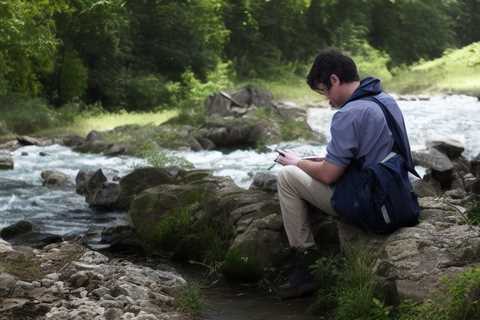A Travelogue is a captivating blend of storytelling and personal experiences, allow readers to embark on an immersive journey through the author’s eyes.
Well-crafted travelogues can transport readers to far-flung destinations, inspiring wanderlust and providing a unique perspective on the world.
In this article, we will explore eleven expert tips to help you master the art of travelogue writing, accompanied by detailed examples to illustrate their effectiveness.
Unlocking the Art of Travelogue Writing | 11 Expert Tips for Captivating Narratives

Tip-1: Choose a Compelling Theme and Purpose for Your Travelogue
Every travelogue needs a central theme or purpose to anchor its narrative.
Selecting a compelling theme ensures that your travelogue maintains a cohesive structure, engages readers, and leaves a lasting impression.
Let’s say you’re writing about your backpacking adventure through Southeast Asia.
A possible theme could be “Embracing Serendipity: A Journey of Unexpected Discoveries.”
By focusing on the serendipitous moments and unexpected encounters throughout your trip, you create a sense of anticipation and curiosity for your readers.
Example: “Embracing Serendipity: A Journey of Unexpected Discoveries”
“As I set foot on the bustling streets of Bangkok, little did I know that my spontaneous decision to travel through Southeast Asia would be a transformative experience filled with chance encounters, breathtaking landscapes, and life-altering realizations.”
Tip-2: Develop Vivid Descriptions and Sensory Detail
Transporting readers to your travel destinations requires the power of vivid descriptions and sensory detail.
Paint a picture with words, engaging all five senses to create a multi-dimensional experience for your readers.
Instead of simply stating, “The beach was beautiful,” delve into the sensory specifics that make it memorable.
Example: “The Enchanting Beaches of Bali”
“As the sun dipped below the horizon, casting a warm golden glow across the azure waters, the salty breeze caressed my face, carrying the faint scent of frangipani.
The powdery white sand cradled my feet as I walked towards the lapping waves, their gentle melody lulling me into a state of tranquility.”
Tip-3: Capture Authentic Moments and Emotions in Your Travelogue
Authenticity is key to crafting a compelling travelogue.
Share the moments that resonated with you on a personal level, and reveal the emotions evoked during your travels.
Authenticity adds depth and relatability to your narrative, allowing readers to connect with your experiences on an emotional level.
Example: “Lost in the Streets of Marrakech”
“As I wandered through the labyrinthine streets of the Medina, the vibrant colors and bustling souks overwhelmed my senses.
The melodic calls to prayer echoed through the air, intertwining with the lively chatter of locals.
Amidst the chaos, I found solace in the genuine smiles of the Moroccan people, their warmth and hospitality leaving an indelible mark on my heart.”
Tip-4: Incorporate Engaging Anecdotes and Dialogue
Anecdotes and dialogue bring your travelogue to life, offering glimpses into the interactions and encounters that shaped your journey.
These storytelling elements create a sense of immediacy and connection with your readers, allowing them to experience the vibrant personalities you encountered along the way.
Example: “Cultural Exchange in Tokyo”
“Sitting in a quaint little izakaya, I struck up a conversation with a local couple, Yuki and Takeshi.
Over a steaming bowl of ramen, they shared stories of their daily lives, their laughter and animated gestures filling the air.
Through broken language barriers, we discovered common ground, fostering a cross-cultural connection that transcended borders and left an enduring impression on me.”
Tip-5: Reflect, Analyze, and Provide Insight
A compelling travelogue not only recounts experiences but also offers reflection and insight.
Share your observations, personal growth, and newfound perspectives gained from your travels.
This adds depth and meaning to your narrative, elevating it beyond a mere recounting of events.
Example: “Lessons from the Himalayan Trek”
“As I navigated the treacherous trails of the Himalayas, I realized the true meaning of resilience and the importance of pushing beyond my comfort zone.
The towering peaks mirrored the challenges I faced, and with each step, I discovered strength within myself I never knew existed.
The Himalayan trek became a metaphor for life, reminding me that growth lies just beyond the familiar horizon.”
Tip-6: Create a Strong Opening Hook in Your Travelogue
The opening lines of your travel story should immediately grab the readers’ attention and entice them to keep reading.
Consider using a compelling anecdote, a thought-provoking question, or an intriguing description to engage your audience from the start.
Example: “In the heart of the Amazon rainforest, where the cacophony of chirping birds and buzzing insects reverberates through the dense foliage, I found myself face to face with a creature so extraordinary, it seemed plucked from the pages of a mythical tale.”
Tip-7: Employ Narrative Arc and Structure
A well-structured travel story follows a narrative arc that includes an introduction, rising action, climax, and resolution.
This structure adds suspense and allows for a satisfying storytelling experience.
Example: “From the crowded streets of Mumbai to the tranquil backwaters of Kerala, my journey across India was a rollercoaster of emotions.
Little did I know that a chance encounter with a wise old Sadhu on the banks of the Ganges would change my perspective on life forever.”
Tip-8: Engage Multiple Perspectives
Broaden the scope of your travel story by incorporating multiple perspectives, not just your own.
Interview locals, fellow travelers, or experts in the region to gather diverse viewpoints and present a well-rounded narrative.
Example: “Through conversations with a Maasai warrior in Kenya, I gained insights into their age-old traditions and the challenges they face in preserving their cultural heritage amidst a rapidly changing world.
Their stories painted a vivid picture of resilience and the unbreakable bond with the land they call home.”
Tip-9: Use Evocative Language
Utilize descriptive language and literary techniques such as similes, metaphors, and personification to evoke vivid imagery in your travel story.
This adds depth and richness to your writing, making it more engaging for readers.
Example: “As the sun dipped below the jagged peaks of the Swiss Alps, the snow-capped mountains turned into molten gold, casting long shadows that stretched like sleepy giants across the alpine meadows.”
Tip-10: Show Cultural Sensitivity in Your Travelogue
When writing about different cultures and customs, it’s important to approach the subject with sensitivity and respect.
Research and understand local traditions, and be mindful of the potential impact of your words.
Avoid cultural stereotypes and focus on fostering understanding and appreciation.
Example: “The traditional Balinese ceremony was a tapestry of colors, music, and spirituality.
The rhythmic clanging of the gamelan orchestra filled the air as the Balinese Hindus offered their prayers, a testament to their deep-rooted connection with nature and the divine.”
Tip-11: Balance Facts and Personal Reflections
Find a balance between sharing factual information about the destination and infusing your personal reflections and experiences.
This allows readers to gain both a sense of place and an intimate connection with your journey.
Example: “Standing before the majestic ruins of Machu Picchu, I marveled at the architectural brilliance of the Inca civilization.
The intricate stone carvings whispered stories of a bygone era, while the mist-laden mountains added an ethereal touch to this ancient wonder.”
Sample Travelogue | Serenade of the Backwaters: A Journey Through Enchanting Kerala
Embark on an extraordinary voyage to Kerala, a land of verdant landscapes, tranquil backwaters, and vibrant culture.
Join me as we delve into the serene beauty of this southwestern state of India, exploring its breathtaking destinations, engaging with its warm-hearted people, and discovering the essence of Kerala’s soul.
Arrival in God’s Own Country: The Aroma of Spices and the Melody of Kathakali
As I stepped off the plane in Kochi, Kerala’s gateway city, a delightful aroma of spices permeated the air, welcoming me to this enchanting land.
Kochi, with its intertwining colonial and traditional influences, was a testament to Kerala’s rich history.
The iconic Chinese fishing nets stood tall against the backdrop of a setting sun, casting their intricate silhouettes on the shimmering waters.
In Fort Kochi, I had the privilege of witnessing the spellbinding performance of Kathakali, a traditional dance form that tells ancient tales through dramatic gestures, vivid costumes, and elaborate makeup.
The dancers’ animated expressions and rhythmic movements transported me to a bygone era, leaving me mesmerized by the artistry and storytelling prowess.
Backwater Bliss in Alleppey: A Sojourn on a Houseboat
Leaving the bustling city behind, I ventured into the serene backwaters of Alleppey, where time seemed to stand still.
Boarding a traditional houseboat, I embarked on a journey through a labyrinth of canals, surrounded by emerald paddy fields and swaying coconut palms.
As the houseboat gently glided across the tranquil waters, I watched the vibrant tapestry of daily life unfold before my eyes.
Villagers washed their clothes along the riverbanks, children waved gleefully from their front yards, and fishermen expertly cast their nets.
The symphony of birdsong accompanied our journey, and the aroma of freshly cooked Kerala delicacies wafted from the boat’s kitchen.
The Hill Station Charms of Munnar: Tea Gardens and Misty Peaks
Venturing into the lush tea-covered hills of Munnar, I found myself immersed in a dreamscape of rolling green plantations and mist-kissed peaks.
Trekking through the winding trails, I discovered the magic of tea production, from the plucking of tender tea leaves to the delicate process of fermentation and drying.
At dawn, I climbed to the summit of Meesapulimala, the highest peak in the Western Ghats, and witnessed the breathtaking spectacle of the sun rising over a sea of clouds.
The cool mountain breeze carried the scent of wildflowers, and the panorama of Munnar’s majestic landscape unfolded beneath my feet.
Serenity on the Shores of Varkala: Sun, Sand, and Spiritual Serenity
Seeking tranquility on Kerala’s coastline, I arrived at the idyllic beach town of Varkala.
The golden sands stretched endlessly along the Arabian Sea, inviting me to surrender to the soothing rhythm of the waves.
Lined with colorful cliffside shacks and yoga retreats, Varkala offered a perfect balance of relaxation and spiritual rejuvenation.
I joined a yoga class on the beach, feeling the gentle warmth of the sun on my skin as I practiced asanas amidst the sound of crashing waves.
As the day drew to a close, I witnessed a mesmerizing sunset, casting vibrant hues across the sky and infusing the atmosphere with a sense of ethereal beauty.
In the End
Kerala, a land of captivating contrasts, revealed itself to me through its stunning landscapes, rich cultural heritage, and warm hospitality.
From the tranquil backwaters of Alleppey to the misty hills of Munnar and the serene shores of Varkala, every moment of my journey through God’s Own Country was filled with wonder and discovery.
Kerala, with its timeless charm, leaves an indelible mark on the hearts of those fortunate enough to experience its splendor.
Conclusion:
Writing a captivating travelogue requires a blend of storytelling prowess, vivid descriptions, and personal insights.
By following tips you can create a travelogue that resonates with readers and transports them to the destinations you explored.
So, pick up your pen, embark on your own writing journey, and share your travel experiences with the world through the power of words.
Bon voyage!




